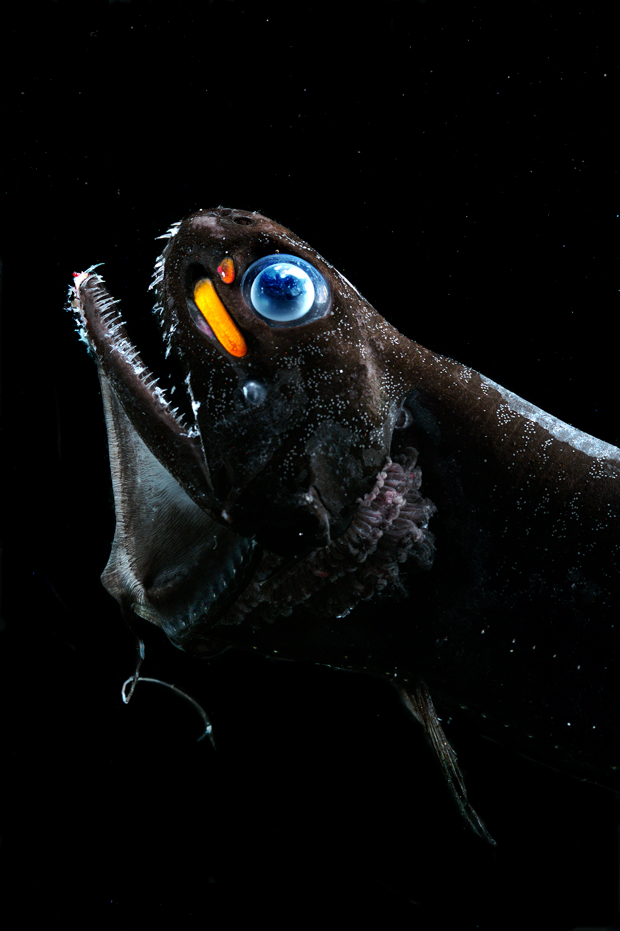Red-Seeing Fish, Blue-Seeing Fish: Deep-Sea Vision Evolves

Fearsome-looking creatures that live in the near-dark to pitch-black waters of the deep sea, dragon fish wouldn't seem to have much need for eyes, let alone the ability to see color. However, some dragon fish have rapidly evolved from blue-light sensitivity to red-light sensitivity, and then back to blue again.
The deep sea is not the sort of environment that would appear to encourage rapid evolution. "It doesn't change. It is always dark," said study researcher Christopher Kenaley, a comparative biologist at Harvard University. "There is something else down there that is driving the evolution of the visual system."
The force driving these changes is likely the bioluminescence produced by the dragon fish themselves as well as by other deep-sea creatures, he said.
Dragon fish, which have outsized jaws and teeth that belie their small size, live between about 650 to 6,600 feet (200 to 2,000 meters) beneath the ocean's surface. About 95 percent of animals in that region can see blue light, which the creatures also produce through bioluminescence. Deep-sea animals, including dragon fish, glow in order to lure prey, communicate with one another or camouflage themselves against the dim light from the surface. Some dragon fish sport lures known as barbels with glowing fibers that resemble blue fiber-optic lights. [A Glow in the Dark Gallery]
Although blue is the default shade of the deep sea, nine species of dragon fish appear to be able to see and bioluminesce in red.
Blue to red and back
To reconstruct the fishes' family history, researchers looked at variations in the sequences that code for the light-sensitive pigment rhodopsin as well as three other genes in samples from 23 groups of dragon fish. (Rhodopsin is not unique to dragon fish; also present in humans, this pigment makes it possible for people to see in dim light.) To clarify when in evolutionary history the different groups of fish split, the researchers used the estimated ages of fossil fish. These established a minimum age for the part of the evolutionary tree into which the fossils fit.
Get the world’s most fascinating discoveries delivered straight to your inbox.
Researchers concluded that red vision evolved once in dragon fish, about 15.4 million years ago. Red-seeing species emit far-red light, which falls at the edge of the spectrum visible to humans. To emit this light, the species use organs called photophores typically located in front of the eye. While the red light can't act as a lure, since most of the animals' prey can't see that shade, it does allow the dragon fish to stealthily illuminate their prey. [Creepy Deep Sea Creatures]
One of these red-seeing species, known as the stoplight loose jaw, still has a blue-green photophore it uses to attract prey before lunging at them with its lower jaw.
About 4 million years ago, some of the red-seeing fish went back to blue. This reversion happened in the "bat of an eye in geological time," Kenaley told Live Science. The analysis the team conducted indicates that two modern groups of blue-seeing dragon fish once had ancestors that relied on red.
"We now understand that visual evolution can be very rapid in a very stabile sensory environment," he said.
Making their own light
Bioluminescence is likely driving the changes in vision, Kenaley said. These creatures co-opted an enzyme called coelenterazine. Used by vertebrates to neutralize free radicals, coelenterazine emits photons, or particles of light. After being filtered by the photophore and its tissue, the light that emerges is blue. What's more, blue light travels further into the deep ocean than other wavelengths do, so it makes sense that deep-sea fish would evolve to see that hue.
The dragon fish that emit red bioluminescence seem to have tweaked the process used to produce blue light, and the evolution of this ability to produce red likely drove the evolution of the ability to see it. Meanwhile, those fish that regained the ability to see in blue may have done so in order to effectively find mates or lure blue-seeing prey, Kenaley said.
This study contradicts previous research that suggested the ability to see red light evolved at least twice independently. Meanwhile, other genetic research grouped blue- and red-seeing fish separately and found no evidence that a red-seeing ancestor reverted to blue.
The journal Evolution recently published a study describing this work online.
Follow us @livescience, Facebook & Google+. Original article on Live Science.



